Unique amino acid signatures that are evolutionarily conserved distinguish simple-type, epidermal and hair keratins
- PMID: 22215855
- PMCID: PMC3258107
- DOI: 10.1242/jcs.089516
Unique amino acid signatures that are evolutionarily conserved distinguish simple-type, epidermal and hair keratins
Abstract
Keratins (Ks) consist of central α-helical rod domains that are flanked by non-α-helical head and tail domains. The cellular abundance of keratins, coupled with their selective cell expression patterns, suggests that they diversified to fulfill tissue-specific functions although the primary structure differences between them have not been comprehensively compared. We analyzed keratin sequences from many species: K1, K2, K5, K9, K10, K14 were studied as representatives of epidermal keratins, and compared with K7, K8, K18, K19, K20 and K31, K35, K81, K85, K86, which represent simple-type (single-layered or glandular) epithelial and hair keratins, respectively. We show that keratin domains have striking differences in their amino acids. There are many cysteines in hair keratins but only a small number in epidermal keratins and rare or none in simple-type keratins. The heads and/or tails of epidermal keratins are glycine and phenylalanine rich but alanine poor, whereas parallel domains of hair keratins are abundant in prolines, and those of simple-type epithelial keratins are enriched in acidic and/or basic residues. The observed differences between simple-type, epidermal and hair keratins are highly conserved throughout evolution. Cysteines and histidines, which are infrequent keratin amino acids, are involved in de novo mutations that are markedly overrepresented in keratins. Hence, keratins have evolutionarily conserved and domain-selectively enriched amino acids including glycine and phenylalanine (epidermal), cysteine and proline (hair), and basic and acidic (simple-type epithelial), which reflect unique functions related to structural flexibility, rigidity and solubility, respectively. Our findings also support the importance of human keratin 'mutation hotspot' residues and their wild-type counterparts.
Figures

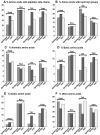
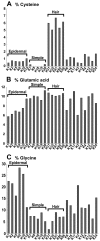
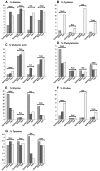

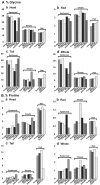
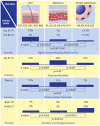
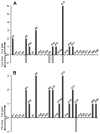
References
-
- Alberts A. J., Lewis J., Raff M., Roberts K., Walter P. (2008). The cytoskeleton. In Molecular Biology of the Cell (ed. Anderson M., Granum S.), pp. 965-1052 New York: Garland Science;
-
- Berg J. M., Tymoczko J. L., Stryer L. (2007). Protein composition and function. In Biochemistry (ed. Zimmerman P.), pp. 25-64, New York: W. H. Freeman;
-
- Blessing M., Nanney L. B., King L. E., Jones C. M., Hogan B. L. (1993). Transgenic mice as a model to study the role of TGF-beta-related molecules in hair follicles. Genes Dev. 7, 204-215 - PubMed
-
- Chen J., Cheng X., Merched-Sauvage M., Caulin C., Roop D. R., Koch P. J. (2006). An unexpected role for keratin 10 end domains in susceptibility to skin cancer. J. Cell Sci. 119, 5067-5076 - PubMed
Publication types
MeSH terms
Substances
Grants and funding
LinkOut - more resources
Full Text Sources
Research Materials

